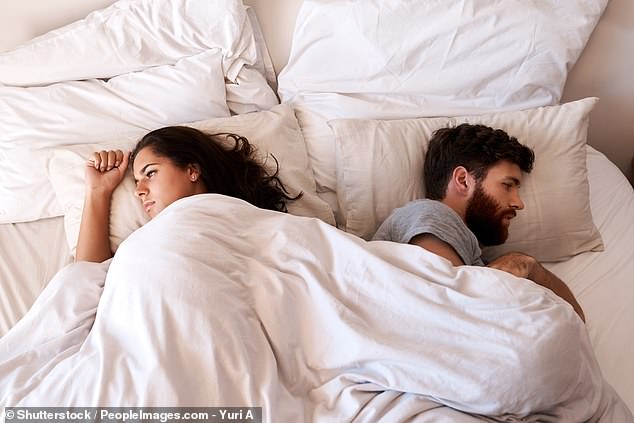New York inspires some unusual sleeping situations, but one couple have resorted to not even staying in the same bed – opting instead for queen-sized bunk beds – and they swear they’ve never been happier.
Casey and Andy, who have been married for five years, regularly share tidbits on TikTok about their snoozing situation, encouraging others to give separate beds a try.
One of the main questions they receive is about how they remain intimate while sleeping in different beds.
‘People seem to think because we don’t like physically sleeping next to each other we must just not touch each other or embrace each other ever in our marriage,’ she shared.
‘Contrary to popular opinion online my husband and I do cuddle almost every night and every morning if one of us isn’t rushing out the door to work – most of our evenings are spent in bed falling asleep, watching a show together,’ she added.


New York inspires some unusual sleeping situations, but one couple have resorted to not even staying in the same bed (stock image)
However, the content creator then shared the obvious difference between couples that share a bed and them.
‘After we’ve been laying together and embracing each other for X amount of time, I head upstairs to my bunk and go to sleep with my cat,’ she said enthusiastically.
She added in the morning’s they will check to see if the other person is awake and go to their bed for a cuddle.
‘It’s such a wonderful way to start your day,’ she gushed. ‘It doesn’t mean you’re literally not touching each other.’
According to Casey, just because they don’t share the same bed it doesn’t mean they don’t touch – they just need to make more of a concentrated effort.
‘Then at the end of the day after we’re done welcoming the other one’s embrace, we’re ready to head on over to our own personal space to get a good night’s sleep for our mental health and physical health,’ she declared.
In another video, Casey said one of the main comments they receive was asking about how they can sleep without skin-to-skin contact.
‘Being hot in my sleep is literally me and Andy’s worst nightmare,’ she said in a video posted to TikTok.


Casey insists it doesn’t affect their intimacy, adding in the morning’s they will check to see if the other person is awake and go to their bed for a cuddle (stock image)








Users shared their views on the couple’s bed situation – some agreeing and other’s staunchly against it
Users were divided over whether or not different beds indicates a healthy relationship.
‘The cornerstone of a healthy relationship is not sleeping apart, or sleeping next to each other, it’s about communicating and doing what’s best for the relationship, regardless of what others think,’ one user argued.
‘I’m a light sleeper with insomnia. My husband snores loudly. Separate bedrooms have saved our marriage, my sanity, and his life!’ another bunk-bed enthusiast shared.
‘King size bed with separate blankets,’ declared another person. ‘It works wonders for us. Whatever works for your relationship is the best option. I have separation issues so I check in my sleep if my hubby is there.’
‘I suggested we get separate blankets, same bed just our own blankets, and my husband looked at me like I told him I was having an affair…’ someone else wrote.
‘Idk… separate comforters do it for me. think it depends on the person. Do y’all not wake up and want to reach over to the person you love?’ questioned someone else.
Couples sleeping in separate beds – or a ‘sleep divorce’ – is not uncommon, with many couples admitting to buying two beds.
Many people claim their partner was interrupting their sleep with their snoring or kicking, others blamed varying schedules or insomnia, while a few social media users admitted they simply needed their own space.
A 2023 survey conducted by the American Academy of Sleep Medicine saw that more than one third of American couples sleep in separate rooms occasionally or consistently.
‘We know that poor sleep can worsen your mood, and those who are sleep deprived are more likely to argue with their partners,’ Dr. Seema Khosla, a pulmonologist and spokesperson for the AASM, said about the study.

